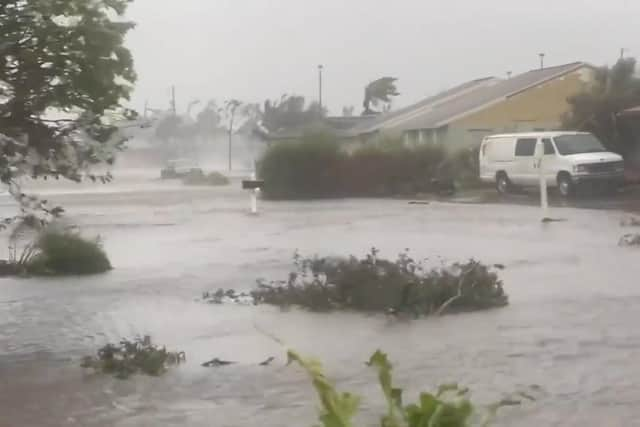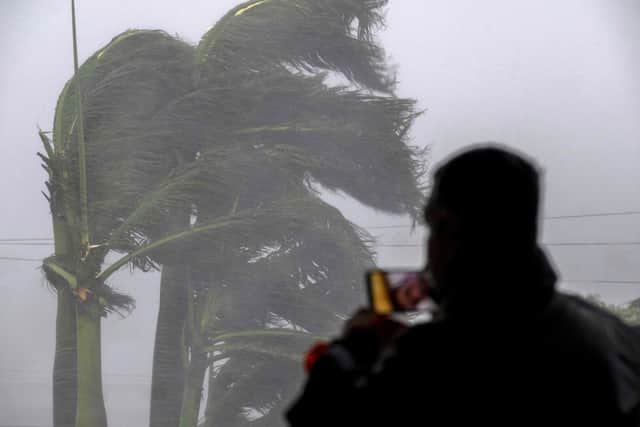Hurricane Ian: Dangerous storm leaves millions without power and neighbourhoods submerged in Florida
Hurricane Ian made landfall around 3:10pm local time on Wednesday, battering the coastline with winds reaching 150mph and torrential rain.
The storm, described by an official as the “biggest flood event” ever seen in south-west Florida, has left a trail of destruction in its wake, with homes and buildings damaged, whole neighbourhoods underwater and trees torn out of the ground.
Advertisement
Hide AdAdvertisement
Hide AdThe roof was ripped off a hospital intensive care unit and many people were left trapped in inundated homes, awaiting rescue.
Footage from affected areas showed water gushing into homes, a petrol station obliterated and yachts being blown down deluged streets.
Firefighters were filmed wading into waist-high waters to rescue people stranded by the storm.
Power suppliers said the violent wind and rain had cut electricity for 2.4 million householders and businesses.


Ian was graded as a category four hurricane when it first hit land, near the city of Fort Myers, but has now been downgraded to a tropical storm as it continues northwards and inland.
The category four grading puts Ian in joint fifth place on the list of the strongest hurricanes – when measured by wind speed – to strike the US.
American meteorologist Mike Seidel, a forecaster with the Weather Channel television network, spent more than five hours in the storm.
He tweeted: “I haven’t experienced anything close to this in over 30 years.”
Advertisement
Hide AdAdvertisement
Hide Ad

About 2.5 million people had been ordered to evacuate south-west Florida before the storm hit, with many still out of their homes.
But Florida residents have been warned the coming 24 hours could be the most dangerous, with people being urged to stay in shelter and keep out of the floodwaters.
The Weather Prediction Center posted a message on Facebook, advising residents in the central Florida peninsula to “expect widespread life-threatening, catastrophic flash and urban flooding” continuing into Friday morning, with as much as 30 inches of rainfall forecast.
Special teams from the US Government’s National Oceanic and Atmospheric Administration (NOAA) took to the air to monitor the extreme conditions from the eye of the storm.
Hurricane hunter Nick Underwood said the mission involved a very bumpy ride.
“When I say this was the roughest flight of my career so far, I mean it,” he said.
“I have never felt such lateral motion.”
The hurricane’s eye made landfall near Cayo Costa, a barrier island just west of heavily populated Fort Myers.
As it approached, water drained out of Tampa Bay.
In Port Charlotte, along Florida’s Gulf Coast, the massive storm surge flooded a lower-level emergency department in a hospital while fierce winds ripped away part of the roof from its intensive care unit (ITU), according to a doctor who works there.
Advertisement
Hide AdAdvertisement
Hide AdWater gushed down on to the ICU, forcing staff to evacuate the hospital’s sickest patients – some of whom were on ventilators – to other floors, said Dr Birgit Bodine of the HCA Florida Fawcett Hospital.
Staff members used towels and plastic bins to try to mop up the sodden mess.
The medium-sized hospital spans four storeys, but patients were forced into just two because of the damage.
Ms Bodine planned to spend the night there in case people injured from the storm arrive needing help.
“As long as our patients do OK and nobody ends up dying or having a bad outcome, that’s what matters,” she said.
Police in nearby Fort Myers received calls from people trapped in flooded homes or from worried relatives.
Pleas were also posted on social media sites, some with video showing debris-covered water sloshing toward homes’ eaves.
Brittany Hailer, a journalist in Pittsburgh, contacted rescuers about her mother in North Fort Myers, whose home was swamped by five feet of water.
Advertisement
Hide AdAdvertisement
Hide Ad“We don’t know when the water’s going to go down, we don’t know how they’re going to leave, their cars are totalled,” Ms Hailer said.
“Her only way out is on a boat.”
Fears over looting amid the chaos prompted police in the worst-hit areas to issue emergency curfews.
Sheriff Bull Prummell of Charlotte County, just north of Fort Myers, announced a curfew between 9pm and 6am “for the safety of citizens”, saying violators may face misdemeanour charges.
“I am enacting this curfew as a means of protecting the people and property of Charlotte County,” Mr Prummell said.
The Weather Underground forecaster predicted the storm would pass near Daytona Beach and go into the Atlantic before veering back ashore in South Carolina on Friday.
The governors of South Carolina, North Carolina, Georgia and Virginia all pre-emptively declared states of emergency.
Forecasters predicted Ian would turn toward those states as a tropical storm, likely dumping more flooding rains into the weekend.
Before making its way through the Gulf of Mexico to Florida, Hurricane Ian tore into western Cuba on Tuesday, killing two people and bringing down the country’s electrical grid.
Advertisement
Hide AdAdvertisement
Hide AdNo deaths have so far been reported from Ian in the US, but a boat carrying Cuban migrants sank in stormy weather east of Key West on Wednesday.
The US coastguard initiated a search-and-rescue mission for 23 people and managed to find three survivors about two miles south of the Florida Keys, officials said.
Four other Cubans swam to Stock Island, just east of Key West, the US Border Patrol said.
Air crews continued to search for possibly 20 remaining passengers.
Comments
Want to join the conversation? Please or to comment on this article.
